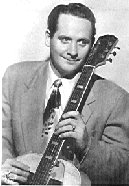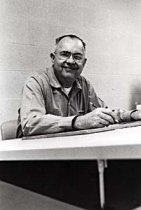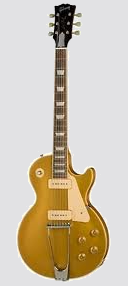Gibson Guitars...
The Solid Body Is Born
Gibson Gets Solid...
Gibson Guitars was doing well in the aftermath of World War II and the purchase by Chicago Musical Instruments. Their ES 150
electric guitar was very popular and a great instrument. However, Gibson's electric guitars as well those of other manufacturers
suffered from one flaw. All the electric guitars of the period were engineered from acoustic guitars. An acoustic guitar is highly resonant
by design. It's how they get their tone and volume. The electric guitars that were engineered from them were either hollow-bodied
or semi-hollow-bodied. The bodies of the guitars were still very resonant.
This resonance is a bad thing in an electric guitar. The electric guitar gets its sound from the strings vibrating above the pickup. This
generates an electric current in the coils of the pickup which is then sent to the amplifier. The problem with an electric guitar's body
resonating means that the body is vibrating and, hence, the pickup is also vibrating. This causes secondary magnetic and electric fields to be generated
which adds extra vibration to the already vibrating string. The result of this is unwanted feedback and overtones(known as harmonics in the music biz).
If it's bad enough it manifests itself as an ear-splitting howl. That can be useful if you play Heavy Metal but Heavy Metal didn't
exist at that point. They needed a solution.
Les Paul

The solution was the solid-bodied guitar. Les Paul(no need to tell you who he is, I'm sure) had been working on the idea since the 1930's. Les
was convinced that not only would the concept work but would also produce a unique sound that hollow and semi-hollow body guitars could not. To
prove his concept he developed "the Log", which was essentially a 4X4 piece of pinewood fitted with two pickups. Spectators were less than enamoured
of the "Log's" looks so Paul glued two cutaway halves of an acoustic guitar body to it to make it look like a guitar. The Log turned out to be a great sounding Jazz guitar without the unwanted feedback and overtones
that the hollow bodied electric guitars had. Les had proved his concept.
Leo Fender

In 1946, Paul took his new guitar to Gibson Guitars. Gibson, however, was not enthusiastic about the idea of a solid bodied electric guitar. Previous attempts to
produce and market a solid body electric guitar had failed and Gibson believed that consumers would still not accept the idea. However, the efforts of
another pioneer in the industry changed their minds. Leo Fender(again, no need to tell you who he is, I'm sure), who at the time owned a radio repair shop in
Anaheim, had built a prototype solid body electric guitar made out of oak in 1943. In 1949, Fender released a production version of the guitar called the Esquire.
Due to name clashes with other manufacturers, the Esquire eventually became known as - wait for it - the TELECASTER! The guitar
had all the sonic characteristics of Les Paul's - great sustain, no feedback or unwanted overtones.
1952 Gibson Les Paul Goldtop

The Telecaster was very successful and prompted Gibson to have a change of heart. Ted McCarty tracked Les Paul down and in 1952 one of
the most popular and iconic electric guitars of all time was released - the Les Paul. Today Gibson produces more variants of the Les Paul
than you can shake a stick at. In addition, there have been many Les Paul "me too's" produced by many manufacturers wanting to cash in
on the popularity of the Les Paul. They say imitation is the sincerest form of flattery but, in business, too much "flattery" will get your
butt sued off. Over the years many manufacturers have been sued for producing blatant copies of Gibson's designs.
In 1957, Chicago Musical Instruments purchased Epiphone and Gibson Guitars gained a sister company. CMI shipped all the Epiphone tooling
to Kalamazoo, Michigan and began production of Epiphones in 1959. At first they were manufactured using the existing Epiphone parts. Later,
Epiphone guitars benefited greatly from the relationship and were manufactured using Gibson parts and authorized designs. Today Epiphones are
still fine instruments and are basically "entry level" Gibson guitars.
Next: Time To Rock!











New! Comments
Have your say about what you just read! Leave me a comment in the box below.